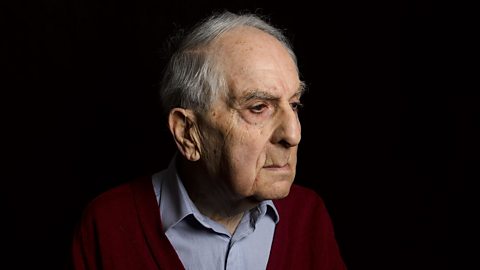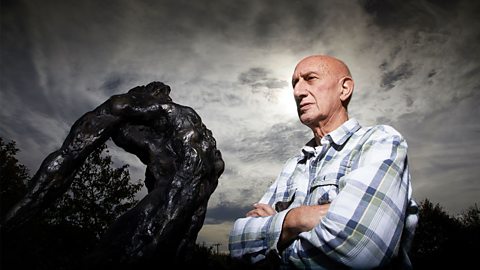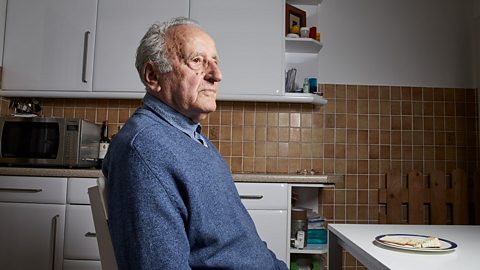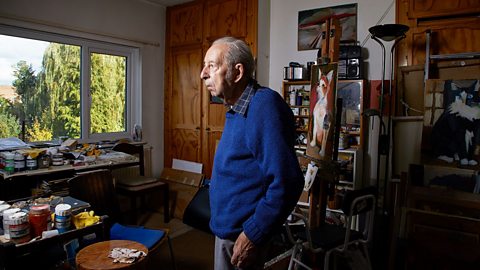MAYA:My mother and her father, on their holidays. You know when you think, what was about to happen, itβs kind of surreal.
My mother gave this to me on Christmas Day and at the time I was really disappointed because I thought what sort of a Christmas present is this. Still pretty strange Christmas present.
She wrote us a letter and this is the letter.
Dear Children, I have written and compiled this document with one thought in my mind, namely that Iβm dedicating it to you and to your children. We have never talked much about those dark days and how it came about that you do not have any grandparents. I was 20 years old when I finally came to England and a mad scramble began to try and make up for lost time. I was hell bent on becoming a cellist and in time a mother. At what point does one start explaining to oneβs child, that there are people in the world who had as their ideology, the total annihilation of Jews and other undesirables, by murdering them in the most sophisticated manner.
ANITA LASKER-WALLFISCH:Who can make sense of it, thereβs no sense in anything that happened. I donβt want to be pitied or whatever. No itβs different times now and hopefully we donβt revert too much into disaster again.
MAYA:What is it like for you to be talking to people who are obviously in no way accountable?
ANITA LASKER-WALLFISCH:Itβs important but the, unfortunately in a miniature, miniature way.
MAYA:Miniature what do you mean?
ANITA LASKER-WALLFISCH:Well because I mean how many people can you affect, itβs like throwing a stone in the water and hoping.
MAYA:But that is, in a way, the only way anything changes, it has to start somewhere.
ANITA LASKER-WALLFISCH:
(IN GERMAN) Thank you for inviting me here to say a few words in the Bundestag. I am one of the rapidly dwindling number of eye witnesses to the catastrophe which befell us all those years ago. It's now more than 70 years since the Holocaust and the perpetrators' generation is no longer alive. We cannot blame today's young people if they refuse to identify with these crimes. But to deny that this is part of German history as well, that must not happen.
Anybody hated anybody, I hated the Germans, even to hear the German language. So you know in a very miniature sort of way, Iβm trying to build bridges thatβs all, and as long as I can do it, Iβll do it, and thatβs all there is to it.
(IN GERMAN) Hate is poison and ultimately those who hate, poison themselves. The future lies in your hands.
I encourage youngsters to ask because we are the last ones. When weβve gone, finished. Then itβs all history books.
Anything else?
Video summary
Auschwitz and Bergen-Belsen survivor Anita Lasker-Wallfisch is invited to Berlin to address the German Parliament, in honour of Holocaust Memorial Day and to caution against forgetting the past.
Prior to the trip, Anitaβs daughter Maya discusses the book her mother made for her 40 years after the war ended, called 'Inherit the Truth'.
Growing up, the family never spoke of what Anita had endured during the Holocaust. The book finally explained to Maya and her siblings the detail of Anitaβs experience and the fate of their extended family.
Anita and Maya travel to Berlin together for Anita's speech and contemplate what difference speaking out as a survivor can make. Anita worries it can do very little.
She uses her speech at the Bundestag to underline the importance of learning the lessons of the Holocaust, to avoid a catastrophe on that scale ever happening again. She has spent many years telling her story, mainly in Germany, as a warning for the future. Within her speech she acknowledges how challenging it is, for young people in particular, to connect with the past but emphasises how important it is to remember.
For many years, Anita would not visit Germany because of the anger she felt following the Holocaust. She wants to build bridges now, while she can, and is mindful that soon there will be no first-hand witnesses left to speak about what happened.
Anita survived Auschwitz as a cello player in the Auschwitz womenβs orchestra. The orchestra would play daily as prisoners marched to work as well as playing for the SS guards whenever required. Following Auschwitz, Anita was interned in Bergen-Belsen, where she was liberated at the end of the war.
After the war she moved to the UK and co-founded the English Chamber Orchestra.
This clip is from the ΒιΆΉΤΌΕΔ series, The Last Survivors.
Due to the sensitive nature of the subject matter, we strongly advise teacher viewing before watching with your students.
Teacher Notes
Does history always repeat itself? Could there be another Holocaust?
Is it important to talk about events of the past? Why?
Does what happened almost 80 years ago have any bearing on the world today?
How important is it to have first-hand accounts of the Holocaust? Can survivorsβ testimonies make a difference?
Anita says that itβs hard for young people to connect to what happened. Why do you think this is? Is it possible to relate to events that took place almost 80 years ago?
Use Anitaβs experience to learn about the Auschwitz orchestra.
This short film will be relevant for teaching history at GCSE and above in England, Wales and Northern Ireland and National 4/5 and above in Scotland.
Frank Bright recounts the fate of his former classmates. video
Frank Bright discusses his work researching the fate of his former classmates, using a class photograph taken in 1942 which he calls βRed for Deadβ.

Maurice Blik confronts the impact of his experiences. video
Maurice Blik confronts the impact of his experiences as a child in Bergen-Belsen, recounting the moment his sister died and how sculpture has helped him to process his trauma.

Manfred Goldberg confronts the death of his brother. video
Manfred Goldberg returns to Germany for the first time since he was a child in 1946 to attend a memorial for his family. In doing so, he finally acknowledges the death of his brother.

Ivor Perl returns to Auschwitz with his daughter. video
Auschwitz survivor Ivor Perl returns to the camp with his daughter Judy for the first time. Sheβs asked Ivor to return in the hope that it will help him, and therefore her, come to terms with the past.

Sam Dresner grapples with his memories of the Holocaust. video
Sam Dresner has no photos of his family, who were murdered when he was a boy. He uses art to recreate what they looked like from memory, and to try and process what he saw.
